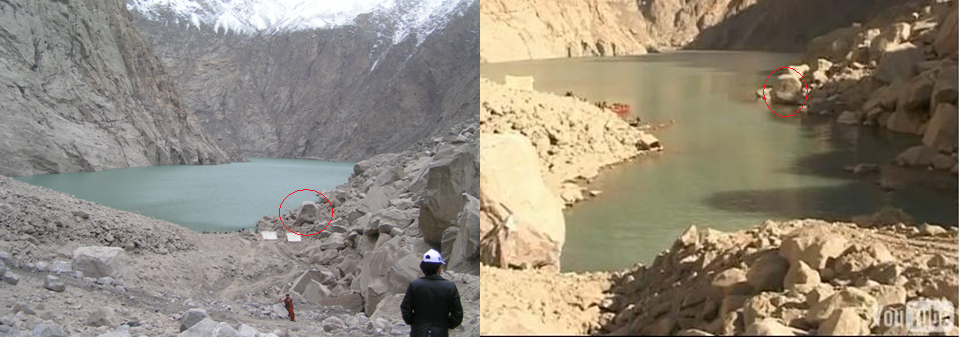1 April 2010
The Attabad lake level, and new seepage points
Posted by Dave Petley
The lake level at Attabad continues to rise at a rate of about 35 cm per day. The Pamir Times website has a Youtube video that contains pictures of the latest situation of the site. Whilst it is not in English, the images give a good overview of the current state of play:
From the video I have captured the following image of the state of the water level in the lake. I have then compared it with a photo that I took from a very similar location a month ago. I have circled the large boulder in red to allow comparison between the images. As usual this should be clearer if you click on the image:
 Meanwhile the local monitoring team organised by Focus Humanitarian Assistance reports that another seepage point has started on the downstream face of the dam. This means that there are now three points, together releasing about 20 cubic feet per second (just over 0.5 cumecs) of water. Although the overall rate of seepage is not increasing substantively at the moment, this development of flow through the dam is a source of concern that needs to be monitored very carefully.
Meanwhile the local monitoring team organised by Focus Humanitarian Assistance reports that another seepage point has started on the downstream face of the dam. This means that there are now three points, together releasing about 20 cubic feet per second (just over 0.5 cumecs) of water. Although the overall rate of seepage is not increasing substantively at the moment, this development of flow through the dam is a source of concern that needs to be monitored very carefully.


 Dave Petley is the Vice-Chancellor of the University of Hull in the United Kingdom. His blog provides commentary and analysis of landslide events occurring worldwide, including the landslides themselves, latest research, and conferences and meetings.
Dave Petley is the Vice-Chancellor of the University of Hull in the United Kingdom. His blog provides commentary and analysis of landslide events occurring worldwide, including the landslides themselves, latest research, and conferences and meetings.
This seems to be rather worrying. Given the instability of the mountain slopes and the frequency of major landslides in the area, I would not want to live anywhere in the Hunza Valley below this lake. I can see 3 possible scenarios. It would take a very powerful earthquake to disrupt the dam itself, but I need not explain what would take place if there was even a partial breach. That’s #1. Even more likely, if there was a large landslide that impacted the lake, we can look to the event that destroyed entire towns below Vajont Dam in Italy, where the resulting wave overtopped the dam by hundreds of feet before killing many hundreds of people below (and that dam actually held). A wave of this proportion would be devastating to an unconsolidated landslide dam. And who knows how large of a wave would be caused. The initial wave created in Lituya Bay, AK, had a 1,700 foot runup on the adjacent mountain slopes. Bad. Lastly, if there was a flood or sudden snowmelt event, the dam could also be overtopped, and the subsequent sustained erosion would likely cause at least a partial breach that could become uncontrollable. In any event, the sane thing for Pakistan to do would be pumping or draining the lake slowly to a much lower level, as was done for Spirit Lake beneath Mt. St. Helens after the 1980 eruption. I can’t speak to the feasibility of tunneling through landslide debris, but something should be done. I would venture to say the same for Lake Sarez in neighboring Tajikistan. As many as 5 million lives are already at risk there, from the lake all the way to the Aral Sea.